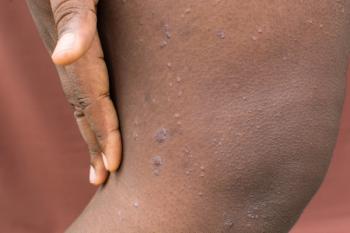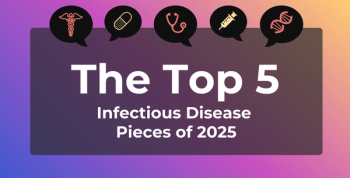
Romosozumab in Clinical Trials for Osteoporosis
Peter L. Salgo, MD: Based on all this, I know you said there were data. There were trials. I’ve gotten this written down. I’m not making this up. There’s the FRAME study, and there’s the ARCH study. What are they?
Thomas P. Olenginski, MD, FACP, CCD: I’m going to try to make these complicated but well-designed studies simple.
Peter L. Salgo, MD: We’re counting on you.
Thomas P. Olenginski, MD, FACP, CCD: The FRAME study had over 7000 women who had osteoporosis.
Peter L. Salgo, MD: Can I stop for a second? Because I caught something here. You mentioned women in studies. You’re mentioning women in studies. This goes back to, where are the men?
Thomas P. Olenginski, MD, FACP, CCD: They’re in studies, but they’re very small. And often, we simply extract from what we see.
Peter L. Salgo, MD: OK, let’s go back to FRAME and ARCH, shall we?
Thomas P. Olenginski, MD, FACP, CCD: FRAME included over 7000 patients. They met a T-score bone-density test for osteoporosis threshold, but they didn’t have a fracture. They were randomized to get romosozumab by injection, monthly, or placebo for the first year. And then after that year, open label, they were given the RANKL inhibitor, denosumab, at 60 mg every 6 months. The intent was to see if there was a separation. Were there fewer fractures? There was a 73% relative risk reduction in the patients who got romosozumab and then got open-label denosumab. And there was a significant reduction in clinical fractures.
The ARCH study was a sicker population, if you will, with over 4000 patients. The intent was, if these patients have osteoporosis and fracture, we’ve got to study them differently. So they were given romosozumab versus standard of care, alendronate, 70 mg weekly, for the first year. Then, open label, they were given alendronate, Fosomax, at 70 mg weekly for the second year. Now, to give you an idea, they had to have a certain level of bone density and they had to have either 1 moderate spine compression, or 1 or more, or 2 mild compressions. Or even with not-so-bad bone density, they had to have 2 moderate compressions or a hip fracture.
Peter L. Salgo, MD: OK, these were sick folks.
Andrea J. Singer, MD, FACP, CCD: Yes.
Thomas P. Olenginski, MD, FACP, CCD: The bottom line: There was almost a 50% reduction in fracture rate in the patients who initially got romosozumab for a year and then got open-label alendronate. There was a reduction in clinical fractures. And the robustness of the response: This was basically a potent, quick-acting drug. That was the study that Dr. Singer alluded to that showed an imbalance. Again, if you take a look, though, even in the other study I mentioned, you have a lot of patients, but there was a small difference in major cardiovascular events.
Andrea J. Singer, MD, FACP, CCD: Let’s talk about 2 things quickly with ARCH. First of all, you’re talking about measuring this new drug against the standard of care, which is a good drug. As Tom mentioned, we know of a 50% reduction in spine fractures, a 19% reduction in nonvertebral fractures, and a 38% reduction in hip fractures compared with an active drug, right?
Peter L. Salgo, MD: Let’s stop there, OK? We’re used to seeing the results of studies where we see, “Oh, it’s 5%, 2%, 8%.” And everybody thinks, “Well, whoa, that’s clinically significant. This is double digits—35%, 50%.” This is big news, yes?
Andrea J. Singer, MD, FACP, CCD: These are relative risk reductions, but this is against a head-to-head comparison with an active agent. It should be very difficult to prove, and yet that’s what the data showed.
Peter L. Salgo, MD: You’re excited, I could see.
Claire Gill: We are excited. I think this creates options for those at highest risk. There are a really limited number of osteoporosis medications. It’s not like cancer and heart disease, where even though we have the highest numbers to match those diseases, we have fewer drugs. So this is an exciting development for patients.
Peter L. Salgo, MD: We’re on a roll because we had these 2 studies, ARCH and FRAME. Now there’s STRUCTURE. What’s STRUCTURE?
Andrea J. Singer, MD, FACP, CCD: I’ll tell you about STRUCTURE, and then I want to come back to that imbalance, in terms of the risk afterward.
Peter L. Salgo, MD: Yes, please. Sure.
Andrea J. Singer, MD, FACP, CCD: STRUCTURE was an active-controlled bone mineral density study. Again, these were women who were deemed to be at high risk for fracture, and they were transitioning from an oral bisphosphonate. All of them had to have been on an oral bisphosphonate for at least 3 years. The median time on the oral bisphosphonate was a little over 6 years. They were then randomized to either get romosozumab or to get teriparatide, which is 1 of the other bone-building drugs that is available, and we know [it] is a very good drug in terms of bone mineral density increases as well as fracture reduction. This was a bone mineral density trial. It was only a year long, in terms of that active comparison piece. We’re not looking at fracture outcomes, but the primary end point was looking at the difference in total hip bone mineral density. There was a 3.2% difference in terms of bone mineral density increases in the group on romosozumab as compared with teriparatide.
Peter L. Salgo, MD: And the presumption would be that if you get more dense bone, the fracture rate will follow?
Andrea J. Singer, MD, FACP, CCD: That would be the presumption, but we do not have that data to be able to make that presumption a fact.
Thomas P. Olenginski, MD, FACP, CCD: We’re talking about technologies. First of all, there’s a technology called trabecular bone score. In some of our older patients who have arthritis, that arthritis kind of fakes the bone density machine out. Their bone density is really good, and it’s not. Trabecular bone score can go and tell you how connected the vertebrae are. Now, in the STRUCTURE study, they used a technique called a VirtuOst by O.N. Diagnostics, LLC. It’s almost a biomechanical CT [computed tomography scan]. So they looked at the strength of the femur. What that surprisingly showed, at least in this 1-year study, was that romosozumab maybe had its benefit in the shell, the cortex, the covering of the bone, and not so much in the inside as maybe we would have expected. In no way does this say that teriparatide is not a great drug. It gives us better tools to strategize and, for the really, really severe osteoporosis patients, hopefully do a better thing.
Newsletter
Stay ahead of policy, cost, and value—subscribe to AJMC for expert insights at the intersection of clinical care and health economics.







































